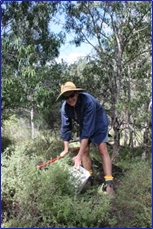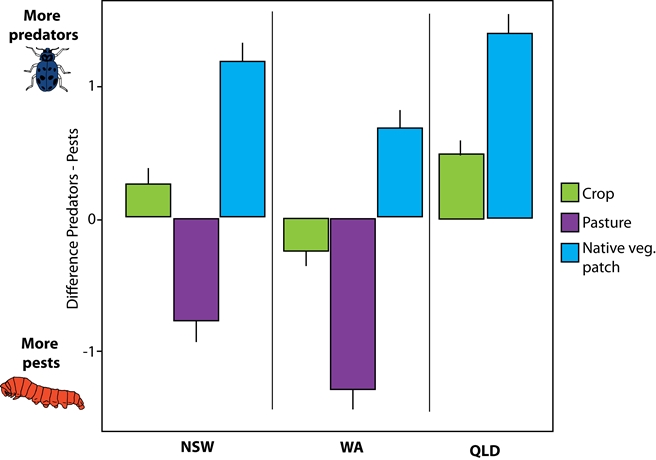Landscape and weed influence on pest and beneficial insect populations
Author: Hazel Parry, Sarina Macfadyen, Nancy Schellhorn, CSIRO Ecosystem Sciences | Date: 17 Jul 2013
Hazel Parry, Sarina Macfadyen, Nancy Schellhorn, CSIRO Ecosystem Sciences
KEY MESSAGES
- Both pests and beneficials can be found in a range of habitats in grain cropping landscapes throughout the year.
- Pastures play a key role in providing habitat for pest populations.
- Pests were more commonly found on exotic weeds than on native plants.
- Native vegetation remnants in good condition (i.e. containing few weeds with an intact understory) may reduce the number of pests and support beneficials.
IMPLICATIONS
- Management of weeds in pasture fields may be crucial for achieving pest suppression in nearby grain crops.
- Highly weedy native vegetation patches may also be a source of pests – take stock of where these are on your property in relation to high-risk crops.
- If you are thinking about re-vegetation there are many ‘low-risk’ native plants that don’t harbour pests but do support adult and immature beneficials.
Grain cropping landscapes consist of a mosaic of different habitat patches that include annual crops such as wheat, barley, canola, cotton, mungbean and sorghum, a range of natural and improved pastures, fallow fields, degraded weedy areas along roadsides, riparian vegetation, and patches of remnant native vegetation. The majority of species present in these landscapes, especially pest species, are good at moving between these habitats and seeking out the resources they need. These different habitats may contain resources such as food and shelter for all or part of the year. Ideally pest suppressive landscapes will have the right mix of habitats that support beneficials and allow them to move into crop fields, but discourage the build-up of pests throughout the year. One objective of our project was to understand which habitats habour pests and support beneficials throughout the year.
What we did
We monitored the numbers of key pests and beneficials monthly for two years (Feb 2010 – Nov 2011) in six landscapes (two in each region of WA, NSW and QLD). We sampled crops, pastures, weeds and native plants for pests and beneficials. The sampling consisted of beating the vegetation into boxes or using a vacuum sampler to suck the arthropods off vegetation. The full dataset comprised almost 30,000 samples!

|

|
What we found
In NSW and WA we found that pastures play a key role across the year in providing habitat for pests (Fig. 1), and native plants provide much better habitat for predators. The pests included many species of sucking pests (aphids, bugs, thrips), and chewing pests (grubs and earwigs). The beneficials included many types of predators (ladybirds, lacewings, spiders).
In the native vegetation remnants we find that, in most cases, weeds host more pests, natives more predators, and grasses host both pests and predators. Weeds that are high risk for pests include nightshade (Solanum nigrum), capeweed (Arctotheca calendula), fleabane (Asteraceae spp.), mustard (Sisymbrium officinale), wild radish (Raphanus raphanistrum) and weed grasses such as ryegrass. Those that are low risk for pests and favoured by predators are native shrubs and Eucalyptus trees.

Figure 1: Difference between the density of predators and pests in each habitat. Bars above zero indicate habitats that are great for predators, less than zero are habitats preferred by pests. lines on each bar show the 95% confidence interval.
Further information
Pest Suppressive Landscapes: Dr. Nancy Schellhorn (CSIRO Brisbane) nancy.schellhorn@csiro.au
About the research presented here: Dr Hazel Parry (CSIRO Brisbane) hazel.parry@csiro.au or Dr Sarina Macfadyen sarin.macfadyen@csiro.au. For further information on plants that host pests and support beneficials in each state go to: www.nipi.com.au/research/pest-suppressive-landscapes/habitat-assessment
Acknowledgements
Many thanks go to the land holders for participating in the project and GRDC for funding (CSE00051). The national project was lead by CSIRO - Nancy Schellhorn, Hazel Parry, Andy Hulthen, Felix Bianchi (Brisbane), Sarina Macfadyen, Mick Neave (Canberra), Paul Yeoh (Perth), and with collaborators from DAFFQ - Jamie Hopkinson, Zara Hall, Adam Quade, and Matt Davis; DAFWA - Svetlana Micic, Art Diggle, Mike Grimm, Tony Dore; UQ – Myron Zalucki.
Contact details
Dr Nancy A Schellhorn
CSIRO Ecosystem Sciences
Brisbane, QLD
Mb: 0428 663 611
Email: Nancy.schellhorn@csiro.au
GRDC Project Code: CSE00051,
Was this page helpful?
YOUR FEEDBACK
